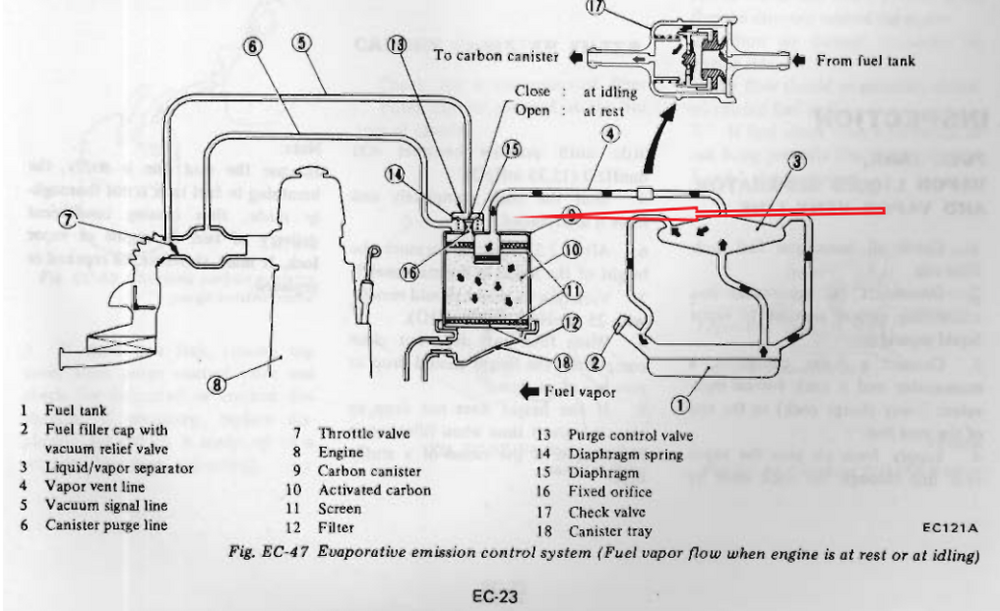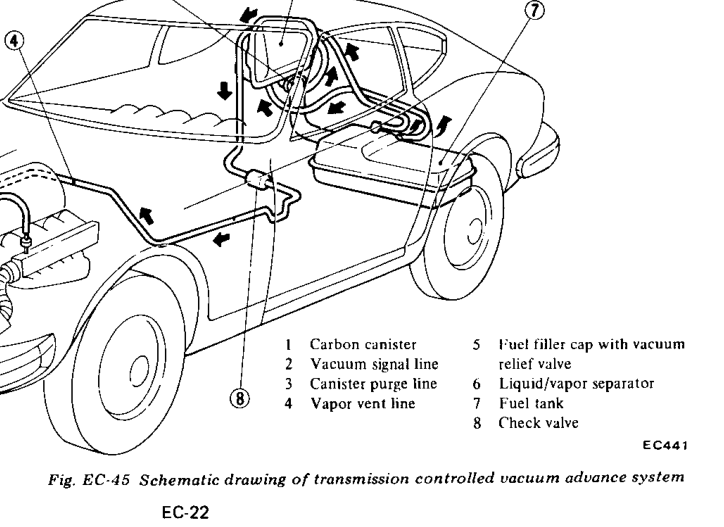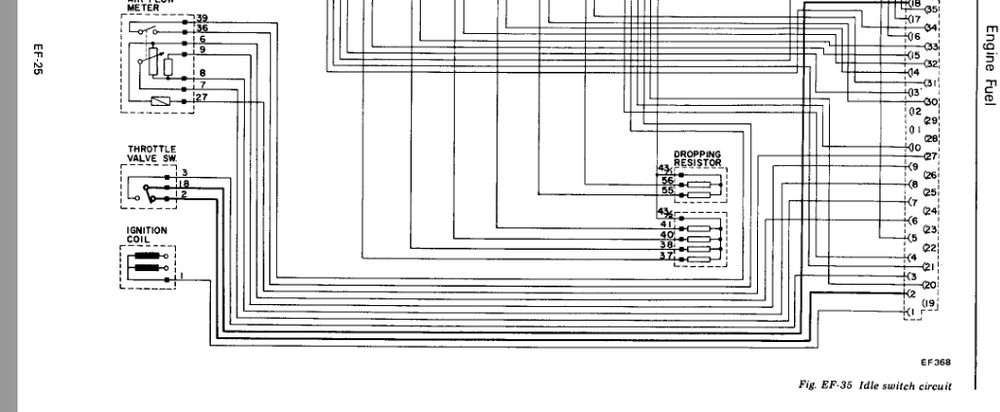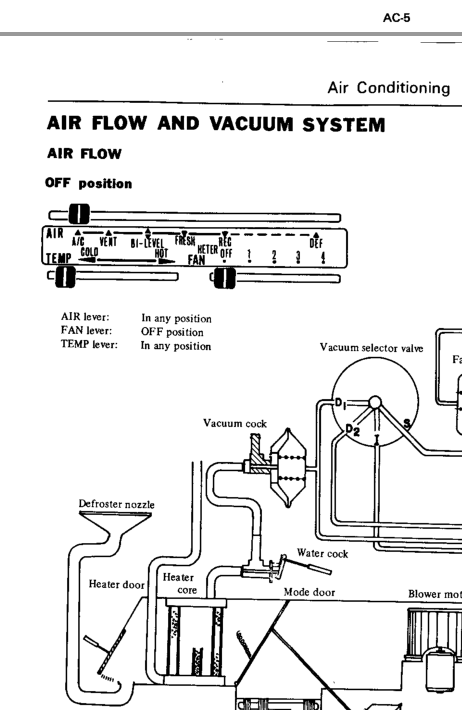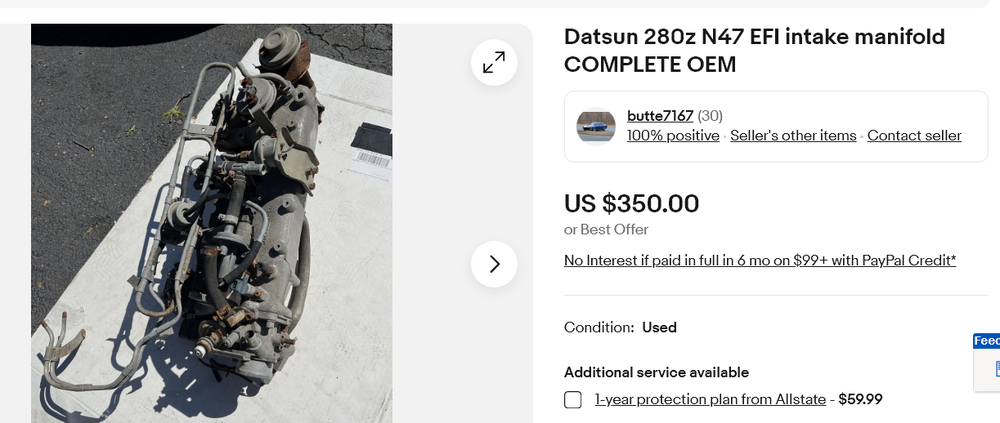Everything posted by Zed Head
-
Vapor Tank Question
My question was about the big hose. Where the fumes would be emitted. Did you block it? That will pressurize the tank. Did you leave it open? That will cause a gas smell as it's open to the tank. Did you leave it connected but with no purge line to the intake manifold? That will also cause a gas smell after the canister charcoal gets loaded with gas vapors.
-
Vapor Tank Question
Actually, the gas cap is sealed and should only let air in, through the "vacuum relief valve". Gasoline fumes from expansion go to the charcoal vapor canister, fresh air is let in through the valve on the gas cap to replaced fuel burned or volume contraction.. I found that the seal on the relief valve on my cap was shot. The cap design was changed for unleaded fuel cars and is still available. The older big-mouth caps are hard to find and very expensive. I just lived with the faint smell. Can't remember what CIC is working with. https://www.classiczcars.com/settings/signature/
-
1973 Rebuild
The F54 block has the holes for the gussets. The N42 block does not. In case you were thinking about a retrofit.
-
Vapor Tank Question
Nissan knows. What did you do with the open end of the hose? And, to be clear, which hose is disconnected. And, more clarity, the canister itself doesn't "hold vacuum". It's wide open on the bottom. The cap on the top controls vacuum to open the purge line that pulls through the canister.
-
running lean '76 280z
I forgot about the AAR. So, my proposal would only work on a hot engine, closed AAR. But that is still air that has passed through the AFM. A stuck AAR won't cause a lean condition.
-
running lean '76 280z
Check the PCV hose under the manifold in to the block.
-
Very Early 69/70 L24 240Z Engine Blocks need a New Home
Why are you hiding the serial number? Seems suspicious. . .
-
'75 280Z - preparing for '06 350Z 6 speed drivetrain conversion
What failed? The top looks in good shape.
-
running lean '76 280z
More ohms. You should be able to kill the engine with the potentiometer. Although, "bogs down" doesn't sound like the lean problem. The lean problem is usually popping back through the intake manifold. And bucking like a horse when you ease in to the throttle. If you can't fix it with the potentiometer you won't be able to fix it via the AFM. This part, below, makes me thing that you might have a vacuum leak. A simple test that I found for vacuum leaks, after I got my engine all figured out, was that I could kill the engine by closing off the idle speed screw. Just drop idle speed until the engine dies. If it never dies then you have a vacuum leak somewhere. Not the AFM idle mixture screw, the throttle body idle speed adjustment screw. The one with the big head that you can turn by hand. Besides that, the screw in the hole on the AFM is only for low air flow adjustments. It shouldn't do much once the engine starts pulling a lot of air. It's just a screw in a small vane bypass port.
-
running lean '76 280z
Why don't you just keep it at 1200 ohms? Not clear what the problem is.
-
Fitting a HEI Module in Transistor Ignition Unit 1977 280Z
What was the tach needle doing?
-
Still struggling with car at idle after 8 years
I have a vague memory of mentioning this in the past, but another reason for fouling plugs is oil. Bad oil rings or valve seals. Since you already have new seals, the only thing that's left is oil rings. On the plugs, pictures after they were cleaned but before they were used again would have been good. Can't tell how much of the brown is permanent staining. The residue around the edges of the plug body, end of the threads, looks pretty thick for such a short drive. Looks more like oil-fouling.
-
Fitting a HEI Module in Transistor Ignition Unit 1977 280Z
Pin 1, injector control, is also on that blue wire. I had found that with the stock ignition module my engine would not run when the tachometer was disconnected. But, after the GM HEI modification it would run without the tach. So, Pin 1 seems to be sensitive to whatever comes through that blue wire. At least it was on my 76 and a 78 parts car that I had. I had the 78 running well, and tried to start ito once with the tach out and it was dead. And later, after messing with the resistor on the 76 it fell out after a drive and the engine wouldn't start. Saw it laying on the passenger floor, put it back on, and back to normal. No idea why it worked with the HEI module though. You might try branching the circuit before the big resistor. One to the tach, one to Pin 1. Or, for an experiment, go back to the non-functional tach setup, low resistance, and see if it still breaks up.
-
Electronic Heater Control Valve
I like the Bronco shutoff valve. Nissan used a vacuum-controlled shutoff valve in their 280Z's. Completely blocked coolant flow through the heater core. Your Bronco valve combines the function of the vacuum cokc and the water cokc.
-
Fitting a HEI Module in Transistor Ignition Unit 1977 280Z
15,800 ohms. About seven times the factory number. Interesting. I wonder what the working then dropping out is all about. Maybe one of the electronics-oriented guy knows.
-
Door lower weatherstripping 280z
Might be for wind/air/road noise blocking and/or wind/draft blocking.
-
Still struggling with car at idle after 8 years
Gundee already mentioned this but one cylinder does not seem to be getting spark. It's not firing. That's why it's clean. I'd fix that before going any farther. No real value in tuning for five cylinders. And if one cylinder is completely sparkless it kind of makes you wonder if the others are getting consistent spark.
-
1977 280z: Randomly running VERY rough
Have you checked the wear patterns on the rocker arm pads? People have had the wrong lash pads installed and the cam lobe rode off the end of the rocker arm. Found a few old threads.
-
1977 280z: Randomly running VERY rough
Thanks SteveJ, but my thought almost had a head pulled. Keeping things simple until they need to get complex is the way to go. Well done. I'd guess that at 300 miles the valve guides are as tight as they'll ever be. Sticking valves seems to be a not uncommon L series engine problem. Might happen again.
-
1977 280z: Randomly running VERY rough
Turn the engine over by hand and see what the valves do. If a valve stays down you should be able to pop the rocker arm off. Might be able to grab the stem and spring retainer and pull it up. Maybe it's something simple like a broken or weak valve spring. Or a rolled over valve seal. It's odd that you would have oil in the cylinder after sitting overnight unless a valve seal wasn't doing its job. Get #1 up on the compression stroke and that should give the most space between cam lobe and rocker arm. Hoping for damaged valve seal and no bent valve...
-
1977 280z: Randomly running VERY rough
Aren't wet and black and black and damp the same thing? If it's running super rich check the FPR vacuum hose for fuel. Maybe the FPR diaphragm failed.
-
1977 280z: Randomly running VERY rough
Hate to say it but the WOT then problems in the morning kind of hints toward a head gasket problem. Like you got some coolant in some cylinders, overnight. I'd pull some plugs and see how they look.
-
Fitting a HEI Module in Transistor Ignition Unit 1977 280Z
I can't remember the numbers from the capacitor I used. Pretty sure I checked once, but it was more to give my meter a workout and to make sure the capacitor was capacitating. You might compare to the stock Nissan capacitor on the postive side. Just to see if the numbers are similar since an old Nissan capacitor had worked for me. Another factor might be that the Nissan tachometers are kind of finicky. What worked on my tachometer might not work on your tachometer. Nissan tachs die in a variety of ways. The one in my 76 was from a 78 parts car. The 76 unit stopped working when it got hot. But, adding resistance seems like a good idea. I'd guess that stronger spark generates stronger kickback. The factory resistor is something like 2.1 or 2.6 kilo ohms, so add accordingly. You're in the 5's, that might be too much.
-
Fitting a HEI Module in Transistor Ignition Unit 1977 280Z
I completely overlooked what you were saying about the test light on the coil while the engine is running. The test light passes current so would not give a clean "break" of the coil primary circuit. The magnetic field collapse would be messed up. Not sure exactly how. Surprised the engine didn't just stop sparking, actually. Make and break is the key to create spark. p.s. if your Volvo capacitor is passing current it would have a similar effect.
-
Am I looking at a monster vacuum leak here?
Post up a link to one for sale. That would be helpful and show how easy they are to find. Pick the best of the many that are available and fork out the small change. Edit - I guess I'm saying that they're not as easy to find as you're implying, and when you do find them they're not cheap. The N42 is the most popular of the EFI intake manifolds. Coincidentally, many people think that Nissan added the webbing to the 1978 manifold to combat the heat soak problem. Subject of a current discussion. I'd look for an N47 (I think) 1978 manifold. Still not cheap. $8 for a tube of SteelStik. https://www.ebay.com/itm/385520584919?mkcid=16&mkevt=1&mkrid=711-127632-2357-0&ssspo=So6yfmz_TvS&sssrc=2047675&ssuid=bBzFtXzvTQO&widget_ver=artemis&media=COPY




